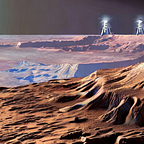Artificial Intelligence and Bioluminescence: Illuminating the Secrets of Nature’s Glow
Introduction: The Allure of Bioluminescence
Bioluminescence has captivated the human imagination for centuries. From the mystical glow of fireflies on a summer evening to the ethereal light emitted by deep-sea creatures, nature’s ability to produce light has long been a source of wonder and intrigue. Now, with the help of artificial intelligence (AI), scientists are beginning to unlock the secrets of bioluminescence, opening up new possibilities in areas like medical research, environmental monitoring, and even artistic expression. Let’s dive into the fascinating world of AI and bioluminescence and discover how this remarkable phenomenon is being illuminated by cutting-edge technology.
Decoding Bioluminescence Through AI
One of the biggest challenges in studying bioluminescence is understanding the complex biochemical processes involved in producing light. AI-driven tools, such as machine learning algorithms, have begun to shed light on these processes by analyzing vast amounts of data and identifying patterns and relationships between various factors. By crunching the numbers and making sense of the data, AI is helping scientists to unravel the mysteries of bioluminescence and gain a deeper understanding of how it works.
AI-Powered Bioluminescent Imaging
Bioluminescent imaging is a powerful technique used to study a wide range of biological processes, from tracking cancer cells to monitoring gene expression. Traditionally, this technique has relied on manual analysis and interpretation of the images, which can be time-consuming and prone to errors. AI has the potential to revolutionize bioluminescent imaging by automating the analysis process, making it more efficient and accurate. Machine learning algorithms can detect subtle patterns and changes in bioluminescent signals, allowing researchers to draw more meaningful conclusions from their experiments.
Enhancing Bioluminescent Sensors with AI
Bioluminescent sensors are devices that use the light-producing properties of certain organisms to detect specific substances or conditions. For example, they can be used to monitor water quality or detect the presence of harmful chemicals in the environment. AI is playing an increasingly important role in the development and optimization of these sensors. By incorporating machine learning algorithms, bioluminescent sensors can be designed to be more sensitive and selective, improving their performance and making them more useful for a variety of applications.
AI and the Art of Bioluminescence
Bioluminescence has also inspired countless artists and designers to create stunning, otherworldly installations that showcase the beauty of nature’s glow. AI is now being used to enhance these artistic endeavors by offering new ways to control and manipulate bioluminescent organisms. For example, AI-driven systems can analyze the behavior of bioluminescent creatures, such as dinoflagellates, and use this information to create dynamic, interactive displays that respond to the environment or human interaction. This fusion of art, science, and technology is not only visually captivating but also serves to raise awareness about the importance of preserving the natural world.
The Future of AI and Bioluminescence
As AI continues to advance, its applications in the study and use of bioluminescence will undoubtedly expand. The combination of artificial intelligence and bioluminescence has the potential to revolutionize fields such as medicine, environmental monitoring, and even entertainment. By unlocking the secrets of nature’s glow, we can develop new technologies and solutions that improve our understanding of the world around us and contribute to a brighter, more sustainable future.
Like the article? Don`t forget to follow us on Medium! Also interesting content on our Instagram, Facebook, and Twitter!
